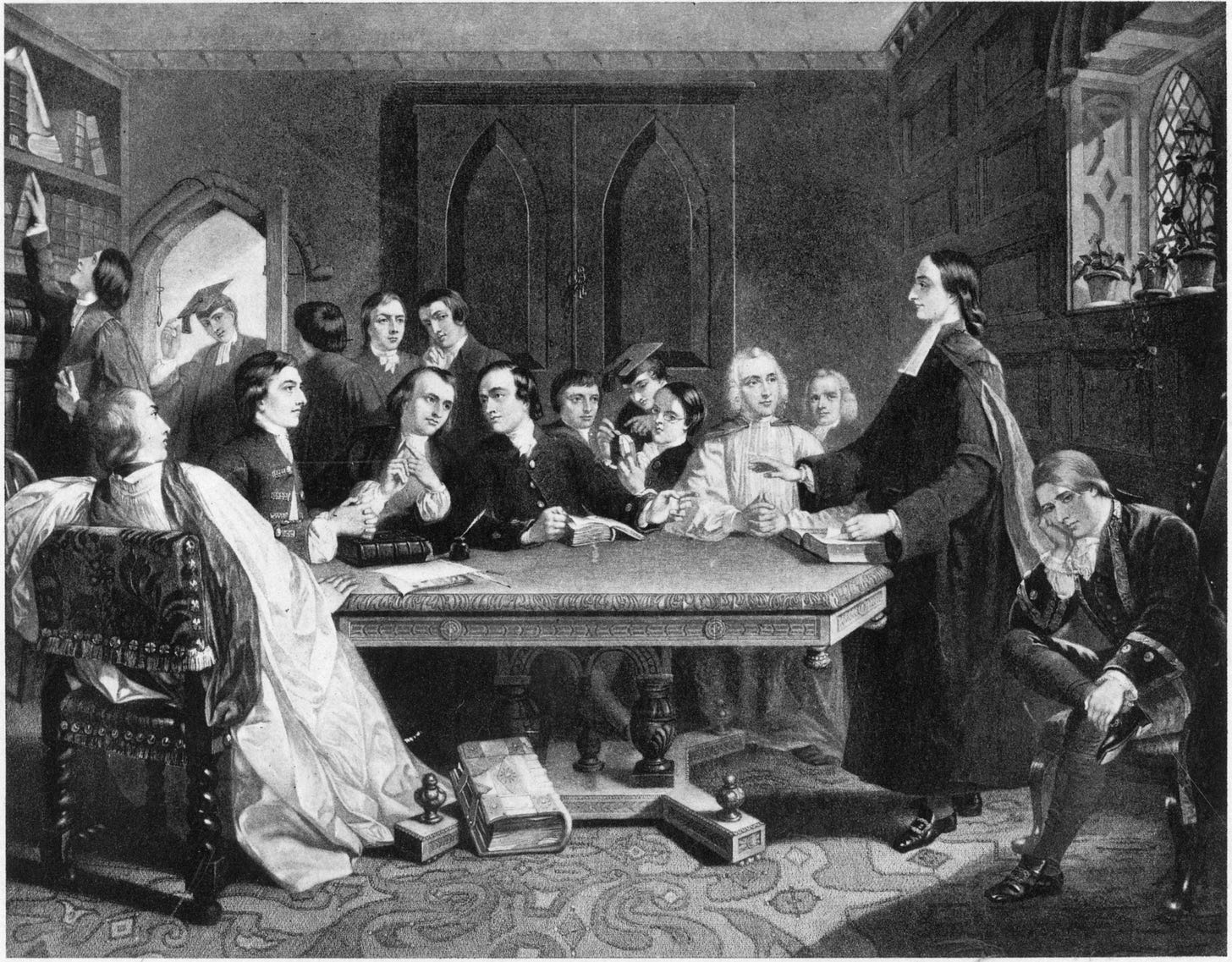The seeds of spiritual growth are often sown through the proclamation of the gospel, but lasting transformation happens most frequently in community. The innovation of field preaching in the early 18th century may have helped launch a new movement, but the genius of Wesley was his structured discipleship through group formation. Wesley once stated,
"Establish class meetings and form societies wherever you preach and have attentive hearers; for, wherever we have preached without doing so, the word has been like seed by the wayside."1
John Wesley effectively organized the Methodist movement through three social building blocks—societies, classes, and bands—each serving a unique role in disciple-making.
Inspired by his friend George Whitefield, Wesley started field preaching in 1739. The method was revolutionary because it bypassed formal church structures to reach the marginalized, including miners, factory workers, and rural communities. Those awakened to the gospel needed further growth in holiness and weren’t finding their way into the traditional Anglican Church.
The Society
With that in mind, Wesley began gathering these new believers into “societies.” Wesley had seen this type of group in action in the 1730s through the Moravian societies. Their practice of mutual accountability, structured spiritual growth, and communal living deeply influenced Wesley's thinking.
Although Wesley was fiercely loyal to the Anglican Church, the societies began to provide a place for new believers to gather for biblical instruction, worship, fellowship, and, eventually, the administration of the sacraments.
The only requirement to join a society was “a desire to flee the wrath to come,” and the proliferation of this growing network of societies became known as the United Societies.
These groups typically met weekly, and the size of each society depended on the location and stage of the movement. Most societies were anywhere from fifty to several hundred people, but in urban centers like London (The Foundry) or Bristol (New Room), societies could grow as large as 1,000 members. These larger societies became hubs for the emerging movement.
Class Meetings
As the United Societies continued to grow and expand, a second gathering was initiated called the class meeting. The first class meetings began in 1742 in Bristol, England, as a way of dividing the society into smaller groups of 10-12 people, with each group committing to collect a weekly contribution from its members. The financial contributions were used not only for society expenses but also for charitable work, such as providing food, clothing, and housing assistance for the needy.
Wesley almost immediately realized their potential for spiritual care and discipleship and transformed them into places of mutual accountability and encouragement in pursuing holiness. Wesley appointed lay leaders to oversee these meetings each week and inquire of group members, “How is it with your soul?”
The class meeting became such a powerful tool that Wesley began to require faithful participation as a requirement to attend the weekly society meeting.
Imagine if pastors and leaders today stood at the front entrance of churches, requiring people to prove their small group attendance that week before entering! This bold requirement ensured deep accountability and set a high bar for those associated with the Methodist movement. The appeal heard in society would be worked out in class meetings to spark behavioral change.
Band Meetings
While the class meeting was required of every person in the movement, the band meeting was voluntary and much smaller in size. Bands were typically 3-5 people, usually of the same gender, and often matched by similar age or marital status. This homogeneity allowed for more candid discussions about personal struggles and sins.
The class meeting was the disciplinary cell of Methodism. The band was the confessional.
While class meetings covered broader spiritual life topics, including victories, struggles, and basic Christian practices, band meetings often delved into private issues, temptations, sins, and shortcomings. Members confessed sins openly to one another, seeking both forgiveness and encouragement.
The band meeting became a place where members would continue to work out their salvation and pursue deeper holiness of heart. In Wesley’s General Rules for Bands, he outlined the purpose and practices of the bands as well as five accountability questions (see footnote).2
Social Holiness
The design of Wesley’s pathway had the goal of holiness in constant focus: the societies focused on biblical teaching and doctrine, the class meeting was designed to implement the behavioral quest for holiness, and the bands facilitated the cultivation of inner purity. It was an interlocking system woven around a common theme.
The society aimed for the head, the class meeting for the hands, and the band meeting for the heart (see chart below).
The Methodist movement gave people a deep sense of belonging, and Wesley's leadership approach emphasized mutual submission. He trained and empowered lay leaders, both men and women, to oversee societies, classes, and bands. This radical departure from the hierarchical norms of 18th-century England demonstrated Wesley's belief in the priesthood of all believers and empowering lay leaders (see Pillar 5).
The idea of social holiness was integral to Wesley's vision of a Christian community that fostered openness, vulnerability, and shared spiritual growth and extended to various aspects of Methodist life, including social reform (see Pillar 6).
People who professed faith in Jesus but showed undisciplined lives by neglecting their class meetings or infrequently attending their society were held accountable or removed from membership.
The impact of Wesley's approach to mutual submission was profound. It created a movement where lay people were empowered to lead while also being held accountable to one another and the broader Methodist structure.
Losing Pillar 8
As early as the 1748 Conference (less than a decade after Wesley began field preaching), other traveling preachers were testifying of the negative impacts of neglecting group formation. They had tried preaching without forming societies and classes as they expanded west and north for more than two years, and the results were disastrous.
Wesley noted in his Minutes,
“Almost all the seed has fallen by the wayside; there is scarce any fruit of it remaining.” The preacher had little opportunity for instructions, the awakened souls could not "watch over one another in love," and the believers could not "build up one another and bear one another's burdens”.3
While the dangers of neglecting group formation and mutual submission were evident, the warnings were often overlooked. As the movement continued to expand, the urgency of the mission, the push for growth, and the demand for respectability contributed to an unfortunate absence of group formation.
Slowly but surely, band meetings and then class meetings were neglected, and a movement once marked by the pursuit of holiness evolved into one marked by a continual desire for growth and respectability.
Today, we see this same dynamic in many of our local churches.
To use Wesley’s terminology, many churches no longer preach in “the fields.” Instead, most of the field preaching takes place in modern-day societies (Sunday gatherings) where new converts are baptized but without clear next steps on how to grow in holiness. The class meetings (small groups) are optional at best, and band meetings (discipleship groups) are almost nonexistent. The result is a lack of deep, transformational growth.
Restoring Pillar 8
To restore Pillar 8, pastors and leaders will need to get serious about accountability and growth in holiness. This is a call to action to implement these principles of mutual submission in our own faith communities and churches.
How can we create spaces where believers can openly share, offer support, and hold one another accountable?
To restore the movement's vitality, we might consider the following steps:
Simplify and strengthen membership commitments, making them meaningful again.
Redefine "attendance" and "membership" to allow for a modern practice of community and participation. Perhaps a commitment to a discipleship group should be required.
Ensure pastors are actively involved in mutual submission, such as being in a band meeting or another accountability group (see Pillar 3).
Reinstate practices that encourage corporate discipleship accountability.
Shift focus from counting general attendees to counting active participants in small groups and discipleship groups.
John Wesley's concept of mutual submission offers a powerful model for contemporary Christian communities. By combining a strong organizational structure of groups with high accountability, we can foster vibrant, growing communities of faith that empower all believers to reach their full potential in Christ and grow in holiness.
Let us take inspiration from Wesley's model and work towards creating churches and faith communities where holiness is not just a concept but a lived reality that transforms lives and impacts the world around us.
Signed,
Jon Wiest, Jeremy Summers, Matt LeRoy, Santes Beatty, Meredith Griffin, Mike Wilson, Billy Wilson, Jervie Windom, Christy Lipscomb, & Dwight Nash
If you want to stay informed about future articles, hit the Subscribe button below and share this with other pastors and leaders in The Wesleyan Church.
Watson, Kevin. (2014) The Class Meeting. Wilmore, KY. Seedbed Publishing, pg. 21.
Wesley’s General Rules for Band Meetings contained the following five questions. 1) What known sins have you committed since our last meeting? 2) What temptations have you faced? 3) How were you delivered? 4) What have you said, or done, of which you doubt whether it be sin or not? 5) Is there anything you desire to keep secret?
Heitzenrater, Richard (2013), Wesley and the People Called Methodists. Nashville, TN. Abingdon Press, pg 184.







{Also sharing this comment as a note so people might find their way back to this post. I recommend it highly for those interested in the methodist movement and those that follow in those traditions, even if not in practice as much}
Such important stuff here about the societies, class meetings, and bands of the Methodist movement. I like that chart and those recommendations are bold but correspond. I suspect that few of us contemporary folk are ready for the fairly extreme level of commitment they had back in the seminal days.
I reflect that several elements of this social holiness meeting substructure are very difficult and in some cases impossible for a crowd to do even in a "society": love feasts and testimonies might take place in a society meeting but not mutual accountability... thus the critical need for the C meetings and bands.
Randy Maddox reflects on John Wesley's insistence on accountability in this way:
"Given the subtleness and deceitfulness of sin, Wesley was convinced that every Christian needed spiritual direction to provide accountability for their growth in holiness." -see Maddox, 1994, p212.
I’m grateful for this article because I am trying to reshape our church’s structure to be more Kingdom from castle type models. I’m grateful for Wesley’s work and pray that as Alphie and I grow in our education and leadership we will be able to grow this Kingdom for the glory, joy, and delight of our Father.